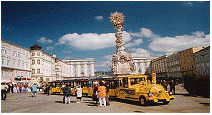| RIVER CRUISE GUIDE | Bank (Danube) | Right/Left | KM | 2135 |
| Altitude | 260m/853ft | Population | 184,000 |
Capital city of Oberösterreich Bundesland (federal state), north-central Austria, Linz lies along the Danube River 100 miles (160 km) west of Vienna. It originated as the Roman fortress of Lentia and became an important medieval trading centre. By the 13th century it had all of the outward characteristics of a city, but none of a city’s rights. It became the provincial capital in the 15th century during the residence of the Holy Roman emperor Frederick III and was noted for its fairs.
An important cultural centre
The see of a Roman Catholic bishop since 1785, Linz has become an important cultural centre, with the Johannes Kepler University (1966), schools of art and music, a college-level Academy of Industrial and Art Design (1947), a seminary, scientific institutes, museums and art galleries, libraries, archives, an opera house, and theatres.
The city is rich in historic buildings, which include the old castle, St. Martin’s Church (first mentioned 799), the early Baroque Town Hall, the 13th-century main square with a monument to the Holy Trinity, the City Parish Church (13th century, remodeled 1648), the Old Cathedral (1669-78), the Minorite (Franciscan) Church (13th century, remodelled 1752-58), and the 16th-century Landhaus (“State House”). Also notable are the monastic churches (Capuchin, Ursuline, Carmelite), the neo-Gothic New Cathedral (1862-1924), and the 19th-century fortifications built by Archduke Maximilian d’Este. The bridge (renewed 1938-39) across the Danube leads to the Urfahr quarter on the left bank beneath the Postling Hill (1,768 feet [539 m]).
On the direct rail route between the Baltic and Adriatic seas
Lying on a direct rail route between the Baltic and Adriatic seas, as well as on the Danube, Linz has extensive docks and a busy river-transit trade. After 1938 it developed into an important industrial centre with ironworks and steelworks and a nitrogen-fixation plant. War damage necessitated their reconstruction after 1945. The city’s manufactures also include machinery, electrical equipment, textiles, glass, furniture, beverages, shoes, rubber, and tobacco products.
If you like cakes, don’t forget to try the Linzer Torte, a spicy cake which is a local specialty.
Don’t know where a place is? Try this map: Map of Austria
Search for Linz hotels, read hotel reviews and book your Linz hotel here >




 Take Better Digital Photos eBook
Take Better Digital Photos eBook Guerrilla Travel Photography eBook
Guerrilla Travel Photography eBook
Leave a Reply